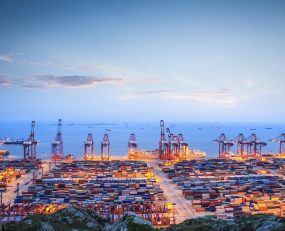
Shanghai port may be reopening but uncertainty over the trajectory of the Chinese recovery remains. The authorities in Shanghai have announced some sort of end to their mass quarantining of the population in China’s largest city but reports on the condition of traffic passing through the port are mixed.
Chinese messaging emphasises that the port is operating at 90% of its capacity with 190,000 TEUs per day being handled by the end of May. The port of Shanghai is also claiming that the number of ships queuing to enter the port is just 30, down from 32 during mid-May.
Other reports emphasise that truck movements in Shanghai remain sharply down even though the Chinese authorities assert that 800,000 movement permits are being issued per-day.
Shippers feeding into the port are also recovering, with the Shanghai Commerce Commission stating that “91% of 142 foreign-funded and foreign trade-related companies in the first group on the government’s list to resume work and production have done so, along with 73% of the 562 companies in the second group and 50% of the 821 in the third”.
What seems more certain is that any major increase in handling of containers and other traffic through the world’s largest port is likely to have a major impact on global shipping network. Once the port fully opens it is assumed that hundreds of thousands of containers presently stuck in Shanghai will hit China facing ports in North America and Europe resulting in a new wave of congestion. There is a probability that this will affect the sort of system dysfunction seen over periods of the past two years, expressed through the mis-location of containers for example.
If or how this will happen is a complex calculation. Many of the leading ports in the West, such as Los Angeles, are seeing less congestion but also slightly lower volumes at present. Consumer spending in the US is less robust than in 2021 although the demand situation moving into the Summer is not too bad and the Port of Los Angeles management is predicting an early peak-season. The impact of higher oil prices cannot be ignored in terms of its impact on the consumer economy nor US monetary policy. In addition, both the size of the container ship fleet and the number of containers in circulation is beginning to increase. It is very unclear what impact all these factors will have on congestion and prices.
It is also very unclear if China has really moved away from its ‘Zero Covid’ policy. The strong possibility remains that a major city in China could again plunge into quarantine. On balance it seems likely that the container shipping sector will not return to normal conditions, with volatility in container flow and prices continuing through this year.
Source: Transport Intelligence, 1st June 2022
Author: Thomas Cullen